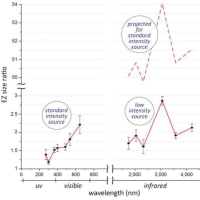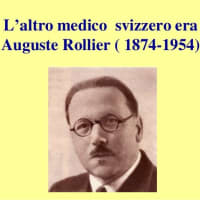2 論文: ビタミンD生成以外の紫外線の有益な効果
UVA誘導性一酸化窒素(NO •)の人体健康に対する有益な役割
数年前、ガス状のフリーラジカルである一酸化窒素(NO • )が、UVAによって皮膚内で非酵素的に誘導されることが実証されました。128 – 130しかし、 UVA誘導性のNO •とそれが人間の生理機能や病態生理機能に及ぼす影響は、NO合成酵素によって酵素的に生成されるNO •の影響ほど十分に研究されていません。131 NO • は細胞膜を急速に拡散することができ、条件によっては数百ミクロン以上拡散することができます。NO •の生物学的半減期は、スーパーオキシド(O 2 •-)、抗酸化物質、酸素濃度に応じて1ミリ秒から2秒の範囲です。2 NO •の生物学的効果は、ヘム基、システイン残基、鉄および亜鉛クラスターなど、いくつかの標的とNO •の反応を介して媒介されます。 NO •の標的が多岐にわたることから、血管拡張、免疫防御、神経伝達、細胞死(アポトーシス)の調節、細胞運動など、NO • が果たす多様な役割が説明できます。NO •の重要性から、紫外線誘導性 NO •濃度の異常な調節は、多くの重要な生物学的プロセスに影響を及ぼす可能性があります。
UVA 照射後の NO •の急速な放出は、潜在貯蔵の存在を示唆している。内因的に生成された NO •の一部が亜硝酸塩 (NO 2 - )、硝酸塩、またはニトロソチオールに変換されることはよく知られている。以前は、これらの化合物は内因性 NO •代謝の不活性最終生成物であると考えられていた。2003年に Rodriguez ら132は、ラットの血管組織で、UVA 照射下で NO 2 -とニトロソチオールは NO •に戻るが、硝酸塩は戻らないことを実証した。
NO 2 - + hν → NO • + O •- .
亜硝酸塩およびニトロソチオールからのNO •放出の作用スペクトルは、約 335 nm にピークを持ち、310~400 nm の範囲にあります。 132人間の皮膚と真皮血管系には、多量の NO 2 - (8.4 µM) とニトロソチオール (2.9 µM ) が含まれており、UVA 放射などの環境刺激によってリサイクルされて NO •を形成します。128~130、133人間の皮膚の重さは約 4 kg で、亜硝酸塩やニトロソチオールなどの NO 誘導体の最大の貯蔵器官と考えることができます。133そのため、皮膚は生物学的に活性な NO •の重要な代替非酵素的生理学的供給源となります。健康な人間の皮膚には、健康なボランティアの血漿よりも25 倍高い濃度の NO 2 -が含まれています。130試験管内ヒトケラチノサイトおよび健康なボランティアにおいて、UVA曝露によりNO合成酵素によって酵素的に生成される濃度と同等かそれ以上の濃度のNOが誘導されることが実証されている。129
UV誘発NOの保護効果•
低濃度の NO • は、培養されたケラチノサイトと皮膚を酸化ストレスと UVA 誘発性アポトーシスから保護します。130 , 131 , 134この皮膚における保護作用のメカニズムと必要な濃度はまだわかっていません。いくつかの研究では、Bcl-2 発現の誘導とカスパーゼ活性化の阻害が示唆されていますが、130この反応の迅速な時間スケールを説明できません。UVA 誘発性の NO •は、UVA 線量に応じて、20~30 分以内に太陽光線誘発性損傷から皮膚を保護する可能性があります。2 つの独立した研究により、ヒト皮膚標本を UVA にさらすと、非酵素的 NO •生成が起こり、20 分後 (320~400 nm、40 J/cm 2 ) または 30 分後 (350~400 nm、30 J/cm 2 )に最大に達することが実証されています。128 , 133
2009 年に Oplander らは、健康な個人に生物学的に関連する量の UVA を照射すると、血圧が持続的に低下することを実証しました。129 2010年には、心臓血管の健康に関連する日光の有益な効果の多くが、ビタミン D や UV への曝露のみとは独立したメカニズムによって媒介され、UVA 誘発性の NO •および亜硝酸塩を介している可能性があると提案されました。135 NO 2 -は長い間、低濃度では生物学的に不活性であると考えられてきましたが、現在では、それ自体が血管を拡張するだけでなく、臓器を虚血/再灌流障害から保護することがわかっています。136ヘモグロビン、ミオグロビン、キサンチン酸化還元酵素、シトクロム P- 450 、およびミトコンドリア酵素はすべて、低酸素条件下でNO 2 -から NO •を生成できます。135 , 137成人では、皮膚と血液の重量と体積は同程度です。表皮中の NO 2 -の総量は約 135 µM であるが、血液中のNO 2 -の総量は13 ~15 µM を超えることはめったにない。133 , 135したがって、比較的大きな表皮の NO 2 -プールのほんの一部を日光によって動員するだけで、血漿中の NO 2 -濃度を一時的に上昇させるのに十分であると考えられる。したがって、Feelisch らは、NO 2 - が全身循環に送達され、冠状動脈拡張作用、心臓保護作用、および降圧作用を発揮できると示唆した。135 NO 含有ガスは、急性および慢性創傷に関連する組織の消毒および炎症プロセスの調節に有効である。138 – 140 UVA誘発性の NO •には抗菌作用があり、皮膚創傷治癒に関与し、抗腫瘍活性もあると提案されている。130 , 141
人間の皮膚がUVAにさらされると、NO • が循環系に放出されます。血流中のNO • は神経系に到達します。129このように、UVAは間接的に神経信号の伝達に影響を与える可能性があります。38
しかし、NO • は有益な効果だけでなく毒性も示す可能性があり、このため、Janus 分子として知られています。130紅斑や浮腫の形成、炎症、早期老化、免疫抑制など、多くの局所的および全身的な UV 誘発反応は、UVA によって生成された NO •の影響を受ける可能性があります。皮膚がんの誘発と進行におけるその役割は不明です。NO •の直接的な毒性はそれほど大きくありませんが、スーパーオキシド (O 2 •- )との反応によって大幅に増強され、強力な酸化剤ペルオキシナイトライト (ONOO - )が形成され、血管と皮膚の酸化損傷を促進する可能性があります。通常の状態では、O 2 •- はスーパーオキシドディスムターゼ (SOD) によって急速に除去されます。NO • は、組織を介して赤血球に急速に拡散することですぐに除去され、そこでオキシヘモグロビンとの反応によって硝酸塩と亜硝酸塩に変換されます。これにより、体内での NO •の生物学的半減期は1 秒未満に制限されます。
結論
紫外線は、ビタミン D 生成とは関係なく、人体の多くのプロセスに影響を及ぼす可能性があります。しかし、どのプロセスが紫外線のみによって媒介され、どのプロセスがビタミン D を介して媒介されるかを理解するのは非常に困難、あるいは不可能です。紫外線のみが効果 (皮膚の日焼けや光保護など) の原因であると疑いなく想定されている状況でも、ビタミン D が重要な役割を果たしている可能性があります。142 – 144 Becklundらの研究120と同様の研究を実験動物でさらに実施し、さまざまな疾患の発生と進行におけるビタミン D と紫外線の影響を区別するためにあらゆる予防措置を講じる必要があります。別のアプローチとしては、ビタミン D による反応とビタミン D とは無関係の反応を識別するために、カルシトリオールを生成できない実験動物や変異したビタミン D 受容体 (VDR) を持つ実験動物で紫外線の影響を研究することが考えられます。
謝辞
本研究は、ノルウェー南東部地域保健局およびノルウェー癌協会の支援を受けて実施されました。
脚注
以前にオンラインで公開されました: www.landesbioscience.com/journals/dermatoendocrinology/article/20013
References
- Banerjee SC, Greene K, Bagdasarov Z, Campo S. ‘My friends love to tan’: examining sensation seeking and the mediating role of association with friends who use tanning beds on tanning bed use intentions. Health Educ Res. 2009;24:989–98. doi: 10.1093/her/cyp035. [PMC free article] [PubMed] [CrossRef] [Google Scholar]
- Ladizinski B, Mistry N, Kundu RV. Widespread use of toxic skin lightening compounds: medical and psychosocial aspects. Dermatol Clin. 2011;29:111–23. doi: 10.1016/j.det.2010.08.010. [PubMed] [CrossRef] [Google Scholar]
- Harrington CR, Beswick TC, Leitenberger J, Minhajuddin A, Jacobe HT, Adinoff B. Addictive-like behaviours to ultraviolet light among frequent indoor tanners. Clin Exp Dermatol. 2011;36:33–8. doi: 10.1111/j.1365-2230.2010.03882.x. [PubMed] [CrossRef] [Google Scholar]
- Agar N, Young AR. Melanogenesis: a photoprotective response to DNA damage? Mutat Res. 2005;571:121–32. doi: 10.1016/j.mrfmmm.2004.11.016. [PubMed] [CrossRef] [Google Scholar]
- Tran TT, Schulman J, Fisher DE. UV and pigmentation: molecular mechanisms and social controversies. Pigment Cell Melanoma Res. 2008;21:509–16. doi: 10.1111/j.1755-148X.2008.00498.x. [PMC free article] [PubMed] [CrossRef] [Google Scholar]
- Miyamura Y, Coelho SG, Wolber R, Miller SA, Wakamatsu K, Zmudzka BZ, et al. Regulation of human skin pigmentation and responses to ultraviolet radiation. Pigment Cell Res. 2007;20:2–13. doi: 10.1111/j.1600-0749.2006.00358.x. [PubMed] [CrossRef] [Google Scholar]
- Wolber R, Schlenz K, Wakamatsu K, Smuda C, Nakanishi Y, Hearing VJ, et al. Pigmentation effects of solar-simulated radiation as compared with UVA and UVB radiation. Pigment Cell Melanoma Res. 2008;21:487–91. doi: 10.1111/j.1755-148X.2008.00470.x. [PMC free article] [PubMed] [CrossRef] [Google Scholar]
- Routaboul C, Denis A, Vinche A. Immediate pigment darkening: description, kinetic and biological function. Eur J Dermatol. 1999;9:95–9. [PubMed] [Google Scholar]
- Suh KS, Roh HJ, Choi SY, Jeon YS, Doh KS, Bae JH, et al. Long-term evaluation of erythema and pigmentation induced by ultraviolet radiations of different wavelengths. Skin Res Technol. 2007;13:154–61. doi: 10.1111/j.1600-0846.2007.00213.x. [PubMed] [CrossRef] [Google Scholar]
- Coelho SG, Choi W, Brenner M, Miyamura Y, Yamaguchi Y, Wolber R, et al. Short- and long-term effects of UV radiation on the pigmentation of human skin. J Investig Dermatol Symp Proc. 2009;14:32–5. doi: 10.1038/jidsymp.2009.10. [PMC free article] [PubMed] [CrossRef] [Google Scholar]
- Hönigsmann H. Erythema and pigmentation. Photodermatol Photoimmunol Photomed. 2002;18:75–81. doi: 10.1034/j.1600-0781.2002.180204.x. [PubMed] [CrossRef] [Google Scholar]
- Auletta M, Gange RW, Tan OT, Matzinger E. Effect of cutaneous hypoxia upon erythema and pigment responses to UVA, UVB, and PUVA (8-MOP + UVA) in human skin. J Invest Dermatol. 1986;86:649–52. doi: 10.1111/1523-1747.ep12275683. [PubMed] [CrossRef] [Google Scholar]
- Yamashita T, Akita H, Astner S, Miyakawa M, Lerner EA, González S. In vivo assessment of pigmentary and vascular compartments changes in UVA exposed skin by reflectance-mode confocal microscopy. Exp Dermatol. 2007;16:905–11. doi: 10.1111/j.1600-0625.2007.00604.x. [PubMed] [CrossRef] [Google Scholar]
- Agin PP, Desrochers DL, Sayre RM. The relationship of immediate pigment darkening to minimal erythemal dose, skin type, and eye color. Photodermatol. 1985;2:288–94. [PubMed] [Google Scholar]
- Mahmoud BH, Ruvolo E, Hexsel CL, Liu Y, Owen MR, Kollias N, et al. Impact of long-wavelength UVA and visible light on melanocompetent skin. J Invest Dermatol. 2010;130:2092–7. doi: 10.1038/jid.2010.95. [PubMed] [CrossRef] [Google Scholar]
- Bataille V, Boniol M, De Vries E, Severi G, Brandberg Y, Sasieni P, et al. A multicentre epidemiological study on sunbed use and cutaneous melanoma in Europe. Eur J Cancer. 2005;41:2141–9. doi: 10.1016/j.ejca.2005.04.038. [PubMed] [CrossRef] [Google Scholar]
- Gandini S, Autier P, Boniol M. Reviews on sun exposure and artificial light and melanoma. Prog Biophys Mol Biol. 2011;107:362–6. doi: 10.1016/j.pbiomolbio.2011.09.011. [PubMed] [CrossRef] [Google Scholar]
- Gordon L, Hirst NG, Green AC, Neale RE. Tanning Behaviors and Determinants of Solarium use Among Indoor Office Workers in Queensland, Australia. J Health Psychol. 2011 doi: 10.1177/1359105311427476. [PubMed] [CrossRef] [Google Scholar]
- Gies P, Javorniczky J, Henderson S, McLennan A, Roy C, Lock J, et al. UVR emissions from solaria in Australia and implications for the regulation process. Photochem Photobiol. 2011;87:184–90. doi: 10.1111/j.1751-1097.2010.00835.x. [PubMed] [CrossRef] [Google Scholar]
- Nilsen LT, Aalerud TN, Hannevik M, Veierød MB. UVB and UVA irradiances from indoor tanning devices. Photochem Photobiol Sci. 2011;10:1129–36. doi: 10.1039/c1pp05029j. [PubMed] [CrossRef] [Google Scholar]
- Matsumura Y, Ananthaswamy HN. Toxic effects of ultraviolet radiation on the skin. Toxicol Appl Pharmacol. 2004;195:298–308. doi: 10.1016/j.taap.2003.08.019. [PubMed] [CrossRef] [Google Scholar]
- Doré JF, Chignol MC. Tanning salons and skin cancer. Photochem Photobiol Sci. 2012;11:30–7. doi: 10.1039/c1pp05186e. [PubMed] [CrossRef] [Google Scholar]
- Rigel DS. Cutaneous ultraviolet exposure and its relationship to the development of skin cancer. J Am Acad Dermatol. 2008;58(Suppl 2):S129–32. doi: 10.1016/j.jaad.2007.04.034. [PubMed] [CrossRef] [Google Scholar]
- Schulman JM, Fisher DE. Indoor ultraviolet tanning and skin cancer: health risks and opportunities. Curr Opin Oncol. 2009;21:144–9. doi: 10.1097/CCO.0b013e3283252fc5. [PMC free article] [PubMed] [CrossRef] [Google Scholar]
- Young C. Solar ultraviolet radiation and skin cancer. Occup Med (Lond) 2009;59:82–8. doi: 10.1093/occmed/kqn170. [PubMed] [CrossRef] [Google Scholar]
- Barysch MJ, Hofbauer GF, Dummer R. Vitamin D, ultraviolet exposure, and skin cancer in the elderly. Gerontology. 2010;56:410–3. doi: 10.1159/000315119. [PubMed] [CrossRef] [Google Scholar]
- Narayanan DL, Saladi RN, Fox JL. Ultraviolet radiation and skin cancer. Int J Dermatol. 2010;49:978–86. doi: 10.1111/j.1365-4632.2010.04474.x. [PubMed] [CrossRef] [Google Scholar]
- Trautinger F, Kindås-Mügge I, Knobler RM, Hönigsmann H. Stress proteins in the cellular response to ultraviolet radiation. J Photochem Photobiol B. 1996;35:141–8. doi: 10.1016/S1011-1344(96)07344-7. [PubMed] [CrossRef] [Google Scholar]
- Shindo Y, Hashimoto T. Ultraviolet B-induced cell death in four cutaneous cell lines exhibiting different enzymatic antioxidant defences: involvement of apoptosis. J Dermatol Sci. 1998;17:140–50. doi: 10.1016/S0923-1811(98)00008-5. [PubMed] [CrossRef] [Google Scholar]
- Agache P, Humbert P. Measuring the Skin: Non-invasive Investigations, Physiology, Normal Constants. In: Agache P, Humbert P, eds. Berlin and Heidelberg GmbH & Co. KG: Springer-Verlag, 2004: 1-807. [Google Scholar]
- Meinhardt M, Krebs R, Anders A, Heinrich U, Tronnier H. Effect of ultraviolet adaptation on the ultraviolet absorption spectra of human skin in vivo. Photodermatol Photoimmunol Photomed. 2008;24:76–82. doi: 10.1111/j.1600-0781.2008.00342.x. [PubMed] [CrossRef] [Google Scholar]
- Fisher DE, James WD. Indoor tanning–science, behavior, and policy. N Engl J Med. 2010;363:901–3. doi: 10.1056/NEJMp1005999. [PMC free article] [PubMed] [CrossRef] [Google Scholar]
- Oren M, Bartek J. The sunny side of p53. Cell. 2007;128:826–8. doi: 10.1016/j.cell.2007.02.027. [PubMed] [CrossRef] [Google Scholar]
- Catania A, Lonati C, Sordi A, Carlin A, Leonardi P, Gatti S. The melanocortin system in control of inflammation. ScientificWorldJournal. 2010;10:1840–53. doi: 10.1100/tsw.2010.173. [PMC free article] [PubMed] [CrossRef] [Google Scholar]
- Gange RW, Blackett AD, Matzinger EA, Sutherland BM, Kochevar IE. Comparative protection efficiency of UVA- and UVB-induced tans against erythema and formation of endonuclease-sensitive sites in DNA by UVB in human skin. J Invest Dermatol. 1985;85:362–4. doi: 10.1111/1523-1747.ep12276983. [PubMed] [CrossRef] [Google Scholar]
- Miyamura Y, Coelho SG, Schlenz K, Batzer J, Smuda C, Choi W, et al. The deceptive nature of UVA tanning versus the modest protective effects of UVB tanning on human skin. Pigment Cell Melanoma Res. 2011;24:136–47. doi: 10.1111/j.1755-148X.2010.00764.x. [PMC free article] [PubMed] [CrossRef] [Google Scholar]
- Moan J, Nielsen KP, Juzeniene A. Immediate pigment darkening: its evolutionary roles may include protection against folate photosensitization. FASEB J. 2012;26:971–5. doi: 10.1096/fj.11-195859. [PubMed] [CrossRef] [Google Scholar]
- Juzeniene A, Brekke P, Dahlback A, Andersson-Engels S, Reichrath J, Moan K, et al. Solar radiation and human health. Rep Prog Phys. 2011;74:1–56. doi: 10.1088/0034-4885/74/6/066701. [CrossRef] [Google Scholar]
- Gambichler T, Boms S, Stücker M, Moussa G, Kreuter A, Sand M, et al. Acute skin alterations following ultraviolet radiation investigated by optical coherence tomography and histology. Arch Dermatol Res. 2005;297:218–25. doi: 10.1007/s00403-005-0604-6. [PubMed] [CrossRef] [Google Scholar]
- Xiang YC, Liu G, Yang L, Zhong JL. UVA-induced protection of skin through the induction of heme oxygenase-1. Biosci Trends. 2011;5:239–44. doi: 10.5582/bst.2011.v5.6.239. [PubMed] [CrossRef] [Google Scholar]
- Gruber F, Oskolkova O, Leitner A, Mildner M, Mlitz V, Lengauer B, et al. Photooxidation generates biologically active phospholipids that induce heme oxygenase-1 in skin cells. J Biol Chem. 2007;282:16934–41. doi: 10.1074/jbc.M702523200. [PubMed] [CrossRef] [Google Scholar]
- Thomas NE, Kricker A, From L, Busam K, Millikan RC, Ritchey ME, et al.Genes, Environment, and Melanoma Study Group Associations of cumulative sun exposure and phenotypic characteristics with histologic solar elastosis. Cancer Epidemiol Biomarkers Prev. 2010;19:2932–41. doi: 10.1158/1055-9965.EPI-10-0686. [PMC free article] [PubMed] [CrossRef] [Google Scholar]
- Walther U, Kron M, Sander S, Sebastian G, Sander R, Peter RU, et al. Risk and protective factors for sporadic basal cell carcinoma: results of a two-centre case-control study in southern Germany. Clinical actinic elastosis may be a protective factor. Br J Dermatol. 2004;151:170–8. doi: 10.1111/j.1365-2133.2004.06030.x. [PubMed] [CrossRef] [Google Scholar]
- Berwick M, Armstrong BK, Ben-Porat L, Fine J, Kricker A, Eberle C, et al. Sun exposure and mortality from melanoma. J Natl Cancer Inst. 2005;97:195–9. doi: 10.1093/jnci/dji019. [PubMed] [CrossRef] [Google Scholar]
- Gillgren P, Brattström G, Frisell J, Persson JO, Ringborg U, Hansson J. Effect of primary site on prognosis in patients with cutaneous malignant melanoma. A study using a new model to analyse anatomical locations. Melanoma Res. 2005;15:125–32. doi: 10.1097/00008390-200504000-00007. [PubMed] [CrossRef] [Google Scholar]
- Garbe C, Büttner P, Bertz J, Burg G, d’Hoedt B, Drepper H, et al. Primary cutaneous melanoma. Prognostic classification of anatomic location. Cancer. 1995;75:2492–8. doi: 10.1002/1097-0142(19950515)75:10<2492::AID-CNCR2820751015>3.0.CO;2-W. [PubMed] [CrossRef] [Google Scholar]
- Grant WB. Skin aging from ultraviolet irradiance and smoking reduces risk of melanoma: epidemiological evidence. Anticancer Res. 2008;28(6B):4003–8. [PubMed] [Google Scholar]
- Vollmer RT. Solar elastosis in cutaneous melanoma. Am J Clin Pathol. 2007;128:260–4. doi: 10.1309/7MHX96XH3DTY32TQ. [PubMed] [CrossRef] [Google Scholar]
- Pukkala E, Martinsen JI, Lynge E, Gunnarsdottir HK, Sparén P, Tryggvadottir L, et al. Occupation and cancer - follow-up of 15 million people in five Nordic countries. Acta Oncol. 2009;48:646–790. doi: 10.1080/02841860902913546. [PubMed] [CrossRef] [Google Scholar]
- Newton-Bishop JA, Chang YM, Elliott F, Chan M, Leake S, Karpavicius B, et al. Relationship between sun exposure and melanoma risk for tumours in different body sites in a large case-control study in a temperate climate. Eur J Cancer. 2011;47:732–41. doi: 10.1016/j.ejca.2010.10.008. [PMC free article] [PubMed] [CrossRef] [Google Scholar]
- Kaskel P, Sander S, Kron M, Kind P, Peter RU, Krähn G. Outdoor activities in childhood: a protective factor for cutaneous melanoma? Results of a case-control study in 271 matched pairs. Br J Dermatol. 2001;145:602–9. doi: 10.1046/j.1365-2133.2001.04432.x. [PubMed] [CrossRef] [Google Scholar]
- Field S, Newton-Bishop JA. Melanoma and vitamin D. Mol Oncol. 2011;5:197–214. doi: 10.1016/j.molonc.2011.01.007. [PMC free article] [PubMed] [CrossRef] [Google Scholar]
- Sivamani RK, Crane LA, Dellavalle RP. The benefits and risks of ultraviolet tanning and its alternatives: the role of prudent sun exposure. Dermatol Clin. 2009;27:149–54, vi. doi: 10.1016/j.det.2008.11.008. [vi.] [PMC free article] [PubMed] [CrossRef] [Google Scholar]
- Feldman SR, Liguori A, Kucenic M, Rapp SR, Fleischer AB, Jr., Lang W, et al. Ultraviolet exposure is a reinforcing stimulus in frequent indoor tanners. J Am Acad Dermatol. 2004;51:45–51. doi: 10.1016/j.jaad.2004.01.053. [PubMed] [CrossRef] [Google Scholar]
- Wintzen M, Yaar M, Burbach JP, Gilchrest BA. Proopiomelanocortin gene product regulation in keratinocytes. J Invest Dermatol. 1996;106:673–8. doi: 10.1111/1523-1747.ep12345496. [PubMed] [CrossRef] [Google Scholar]
- Cui R, Widlund HR, Feige E, Lin JY, Wilensky DL, Igras VE, et al. Central role of p53 in the suntan response and pathologic hyperpigmentation. Cell. 2007;128:853–64. doi: 10.1016/j.cell.2006.12.045. [PubMed] [CrossRef] [Google Scholar]
- Skobowiat C, Dowdy JC, Sayre RM, Tuckey RC, Slominski A. Cutaneous hypothalamic-pituitary-adrenal axis homolog: regulation by ultraviolet radiation. Am J Physiol Endocrinol Metab. 2011;301:E484–93. doi: 10.1152/ajpendo.00217.2011. [PMC free article] [PubMed] [CrossRef] [Google Scholar]
- Heckman CJ, Egleston BL, Wilson DB, Ingersoll KS. A preliminary investigation of the predictors of tanning dependence. Am J Health Behav. 2008;32:451–64. doi: 10.5993/AJHB.32.5.1. [PMC free article] [PubMed] [CrossRef] [Google Scholar]
- Levins PC, Carr DB, Fisher JE, Momtaz K, Parrish JA. Plasma beta-endorphin and beta-lipoprotein response to ultraviolet radiation. Lancet. 1983;2:166. doi: 10.1016/S0140-6736(83)90150-2. [PubMed] [CrossRef] [Google Scholar]
- Wintzen M, Ostijn DM, Polderman MC, le Cessie S, Burbach JP, Vermeer BJ. Total body exposure to ultraviolet radiation does not influence plasma levels of immunoreactive beta-endorphin in man. Photodermatol Photoimmunol Photomed. 2001;17:256–60. doi: 10.1034/j.1600-0781.2001.170602.x. [PubMed] [CrossRef] [Google Scholar]
- Gambichler T, Bader A, Vojvodic M, Avermaete A, Schenk M, Altmeyer P, et al. Plasma levels of opioid peptides after sunbed exposures. Br J Dermatol. 2002;147:1207–11. doi: 10.1046/j.1365-2133.2002.04859.x. [PubMed] [CrossRef] [Google Scholar]
- Kaur M, Liguori A, Fleischer AB, Jr., Feldman SR. Plasma beta-endorphin levels in frequent and infrequent tanners before and after ultraviolet and non-ultraviolet stimuli. J Am Acad Dermatol. 2006;54:919–20. doi: 10.1016/j.jaad.2006.01.062. [PubMed] [CrossRef] [Google Scholar]
- Kaur M, Liguori A, Lang W, Rapp SR, Fleischer AB, Jr., Feldman SR. Induction of withdrawal-like symptoms in a small randomized, controlled trial of opioid blockade in frequent tanners. J Am Acad Dermatol. 2006;54:709–11. doi: 10.1016/j.jaad.2005.11.1059. [PubMed] [CrossRef] [Google Scholar]
- Nolan BV, Feldman SR. Ultraviolet tanning addiction. Dermatol Clin. 2009;27:109–12, v. doi: 10.1016/j.det.2008.11.007. [v.] [PubMed] [CrossRef] [Google Scholar]
- Nolan BV, Taylor SL, Liguori A, Feldman SR. Tanning as an addictive behavior: a literature review. Photodermatol Photoimmunol Photomed. 2009;25:12–9. doi: 10.1111/j.1600-0781.2009.00392.x. [PubMed] [CrossRef] [Google Scholar]
- Kourosh AS, Harrington CR, Adinoff B. Tanning as a behavioral addiction. Am J Drug Alcohol Abuse. 2010;36:284–90. doi: 10.3109/00952990.2010.491883. [PubMed] [CrossRef] [Google Scholar]
- Roelandts R. The history of phototherapy: something new under the sun? J Am Acad Dermatol. 2002;46:926–30. doi: 10.1067/mjd.2002.121354. [PubMed] [CrossRef] [Google Scholar]
- Møller KI, Kongshoj B, Philipsen PA, Thomsen VO, Wulf HC. How Finsen’s light cured lupus vulgaris. Photodermatol Photoimmunol Photomed. 2005;21:118–24. doi: 10.1111/j.1600-0781.2005.00159.x. [PubMed] [CrossRef] [Google Scholar]
- Lawrence G. Tools of the trade: the Finsen Light. Lancet. 2002;359:1784. doi: 10.1016/S0140-6736(02)08653-1. [PubMed] [CrossRef] [Google Scholar]
























